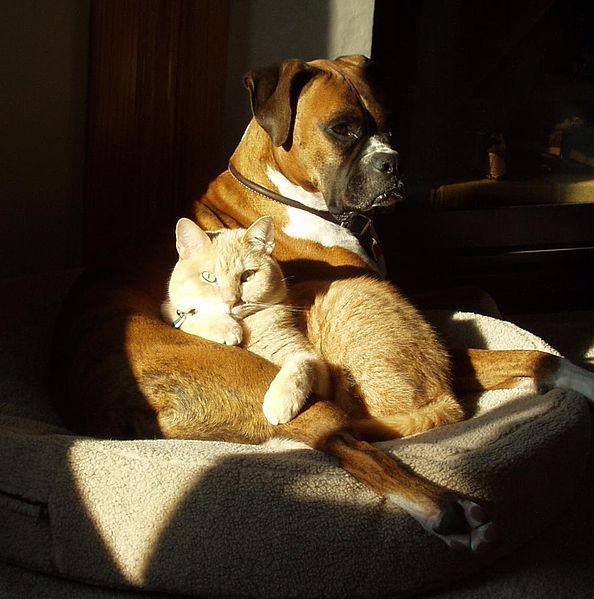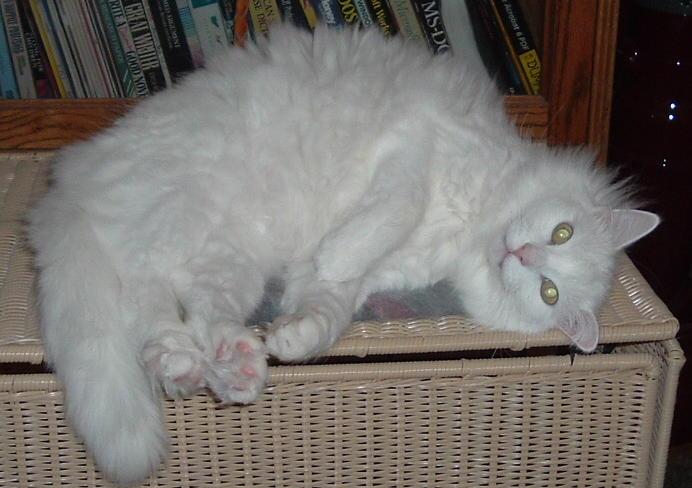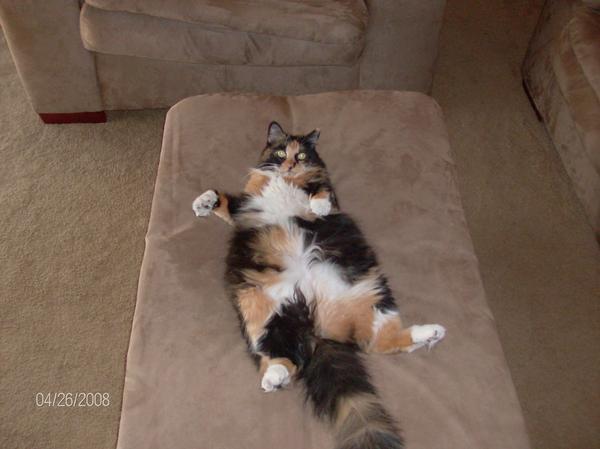10 Myths About Cats

Cats have been revered in ancient societies and today are one of the most popular pets in the United States. Though often aloof and appearing to be a solitary creature, cats are social animals and can be quite affectionate with their human companions. It is no surprise the feline has many myths attached to its legacy. Most impassioned cat owners know the truth about their furry friends, but there are many others who believe the myths that have endured over the years. Lets take a look at ten myths about cats and explore fact or fiction?
Myth 1 - Declawing a Cat Doesnt Hurt it.
This is fiction. Declawing a cat involves amputating the last bone of the cats claw (toe). While some cats fully recover from the operation, many do not. They may develop behavior problems to compensate for the lack of claws. Since claws are used for climbing as well as defense, the cat must learn new ways to defend itself and to climb. In addition, a cat walks on its toes and therefore, for some cats, walking becomes extremely painful after declawing. It would be similar to a humans toes being amputated at the last joint and then walking on the toes.
Myth 2 Black 
Cats Bring Bad Luck
This is fiction. This is a tale that has endured for centuries and started in the middle ages when black cats were associated with witchcraft and black magic. While in the United States a black cat crossing an individuals path is bad luck, in Japan it is considered good luck. It seems superstitions about black cats, and white cats by the way, are abundant. However, black cats have no supernatural power to change the luck of humans.
Myth 3 Cats Hate Dogs
This is fiction. It has been assumed cats hate dogs and dogs love to chase cats. In reality both animals are predators in the wild so this would seem to support animosity between the two species. In domesticated dogs they have a natural instinct to fetch and chase. They see cats as a pl
aything for the most part. Other dog breeds are hunters and see cats as something they are supposed to hunt and catch. There is also an issue of territory. Dogs will often chase cats to get them out of what they perceive as their territory. Domestic cats do not often attack dogs on a whim. There are a multitude of cats that get along quite well with dogs.
Myth 4 Cats Need Milk
This is fiction. The only milk cats need is the mothers milk when its a kitten. Many cats have difficulty digesting the lactose in milk and as a result experience nausea, gas, or vomiting. These cats commonly have diarrhea from drinking milk. When kittens are born, they have lactase in their stomach (lactase digests the lactose in milk), but as they grow, they produce less. Lactose intolerance is common in cats because their mothers milk is the only naturally occurring exposure to milk sugar. Cows milk contains more lactose than a mother cats milk, so even kittens will not tolerate a diet of cows milk. Orphaned kittens should be fed a milk replacement formulated for a kittens digestion.
Myth 5 Cats Steal the Breath of Babies
This is fiction. Cats do not have the ability to suck in the breath of a sleeping baby. The origin of this myth likely came from sudden infant death syndrome (SIDS). In the 1700s SIDS was not yet recognized. It is common for cats to find the highest, most comfortable place to sleep, so curling up in a babys crib wasnt unusual. Cats are curious as well and have a great sense of smell. They would put their nose close to the babys mouth, smelling the milk on the breath. With nothing to explain SIDS, people looked to the cat as the culprit.
Myth 6 Cats Have Nine Lives
This is fiction. This myth probably comes from the cats seeming ability to get out of a multitude of situations unscathed, but the actual origin of the myth is unknown. One theory is the number nine may come from the trinity of trinities, a mystical number from ancient religion and folklore. In ancient Egypt the cat was revered and in the ancient suburb of Cairo called On, a priesthood worshipped the sun God Atum-Ra. Atum-Ra gave life to the gods of air, moisture, sky and earth, who begat Osiris, Isis, Seth and Nephthys. Collectively, these gods are known as Ennead, or the Nine. Atum-Ra took the form of a cat to visit the underworld and embodied the nine lives.
Myth 7 Whatever is Ailing a Cat can Wait Until its Next Scheduled Exam
This is fiction. Cats are notorious for hiding ailments; therefore, if a cats behavior is suspect in regards to its health, a visit to the vet is warranted. Often early diagnosis means the difference between something minor with a quick recovery, to something major or even life threatening. This is especially true for older cats. Often owners believe an ailment is simply because the cat is aging, but age itself is not a singular predictor of the cats current or future health. Many people believe once a cat is elderly, nothing can be done about age-related health problems. This is far from true. Many symptoms associated with aging can be managed. These include decreased activity, bad breath, elimination accidents, changes in appetite, and periods of confusion or disorientation.
Myth 8 Most White Cats are Deaf and Blind
This is both fact and fic
tion. Most white cats are not blind, but they are often deaf. White cats with blue eyes are more likely to be deaf than white cats with green eyes. Cats with one blue eye and one green eye are often deaf on the side of the blue eye. The higher probability of deafness in white cats is due to the location of the gene for deafness. It is fairly close to the gene for white hair and blue eyes. When one gene is passed to the offspring, sometimes the nearby genes get passed along as well.
Myth 9 - All Calico Cats are Female
This is fiction. Calico cats can be male but it is rare and they are generally sterile (unable to breed). The reason for this has to do with the color pattern. Calico is not a breed of cat, but rather a color pattern. A true calico has blocks of three colors: black white and orange, though variations of these colors includ
e ginger, gray and cream. Cats with a swirled blend of these three colors, called a tortoise shell, or tortie are also often called calico. A simplistic explanation follows: Coat color is a trait linked to the sex chromosome in cats. The coding for black or orange color is found on the X chromosome. Females have two X chromosomes and males have one X and one Y; therefore, females are more likely to have the two colors. White is coded on a separate gene. The only time calico cats are male is when a male cat has an XXY genetic coding.
Myth 10 - Cats Cant be Taught Tricks
This is fiction. It has long been believed cats cant be taught tricks and this is most likely due to their seemingly independent nature. However, as stated previously cats are social animals and highly intelligent.Cats can be taught to use the toilet, fetch, walk on a leash, shake paws, and many other tricks and useful behaviors. Cats work well with food rewards, but a cat that is bonded with its owner may also work well with other rewards. As with other animals, training cats takes patience and consistency.
The felines characteristics leave it open for a myriad of myths and folklore about cats. However, the treatment of cats shouldnt be based on old-wives tales or fairy tales. Cats are amazing, intelligent creatures that provide comfort, affection, and companionship to many people.
References:
Fortney, William DVM. (2011- Fall). The truth about (older) cats and dogs. Healthy Pet (no volume or issue), 6-8.
Stewart, Portia. (2011 Winter). Kitty myths true or false?. Healthy Pet, (no volume or issue), 20-21.
Vetmedicine.about.com Accessed March 18, 2012. http://vetmedicine.about.com/od/catbreed1/f/FAQ_calicocats.htm
The copyright of the article 10 Myths About Catsis owned by Cheryl Weldon and permission to republish in print or online must be granted by the author in writing.
- All About Polydactyl Cats
By Julia Williams Polydactyl cats are not a specific breed, but they do have a unique characteristic that is immediately noticeable – extra toes! These extra toes make their paws look gigantic, rather like they are wearing mittens, hence the nicknames...
- A Kitty Cat Trivia Quiz, Just For Fun!
By Julia Williams If you’re a “cat person” like me (now…don’t go calling me crazy just because I love cats!) then you probably know a lot about them. Test your knowledge of kitty cat trivia with this fun quiz. 1. Calico cats are almost...
- Cat Breed Profile: Maine Coon
By Suzanne Alicie The breed of feline known as the Maine Coon is a domestic cat with a very distinctive appearance. This is one of the oldest natural breeds of cat in the United States, and is not only native to the state of Maine but is also the official...
- Norwegian Forest Cat: Ancient Breed Has Mythological Origins
By Lexiann Grant The Norwegian Forest cat is, as its name indicates, a cat of Scandinavian descent. A breed believed to be between 1,000 and 2,000 years old, the "Wegie" was the cat of the Vikings, living as a ratter on both farm and ship. Breeders from...
- A “coat” Of Many Colors…
Tabby, Calico, Gray – okay, well gray is kind of easy, but you get the idea. What kinds of colors are available for cats? And how do you know what you have? We have the answers for you.Interesting FactTri colored cats are almost always female. About...
